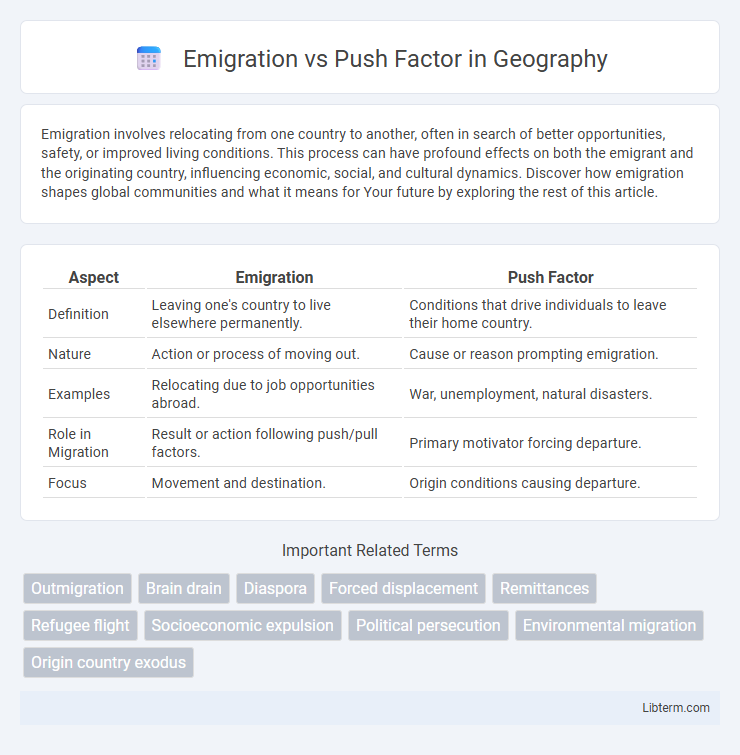Emigration involves relocating from one country to another, often in search of better opportunities, safety, or improved living conditions. This process can have profound effects on both the emigrant and the originating country, influencing economic, social, and cultural dynamics. Discover how emigration shapes global communities and what it means for Your future by exploring the rest of this article.
Table of Comparison
| Aspect | Emigration | Push Factor |
|---|---|---|
| Definition | Leaving one's country to live elsewhere permanently. | Conditions that drive individuals to leave their home country. |
| Nature | Action or process of moving out. | Cause or reason prompting emigration. |
| Examples | Relocating due to job opportunities abroad. | War, unemployment, natural disasters. |
| Role in Migration | Result or action following push/pull factors. | Primary motivator forcing departure. |
| Focus | Movement and destination. | Origin conditions causing departure. |
Understanding Emigration: Definition and Scope
Emigration refers to the act of leaving one's country or region to settle permanently in another, driven by various personal, economic, or social motivations. Understanding emigration involves analyzing its scope, which encompasses voluntary migration for better opportunities as well as forced movement due to adverse conditions. The concept distinguishes itself from push factors by focusing on the decision to move, whereas push factors emphasize the negative circumstances compelling individuals to leave.
What Are Push Factors? Key Concepts Explained
Push factors are conditions that drive individuals to leave their home country due to negative circumstances such as economic hardship, political instability, environmental disasters, and social unrest. These factors create an unfavorable living environment, prompting migration to seek better opportunities elsewhere. Understanding push factors is essential in analyzing migration patterns and the reasons behind emigration flows globally.
Differences Between Emigration and Push Factors
Emigration refers to the act of leaving one's country or region to settle elsewhere, driven by personal choice or external circumstances. Push factors are specific adverse conditions such as economic hardship, political instability, or environmental disasters that compel individuals to emigrate. The key difference lies in emigration being the action or process of departure, while push factors are the underlying reasons causing individuals to make that decision.
Major Push Factors Influencing Emigration
Major push factors influencing emigration include economic instability, such as high unemployment rates and low wages, prompting individuals to seek better job opportunities abroad. Political unrest, including war, persecution, and lack of political freedom, also drives people to leave their home countries in search of safety and stability. Environmental challenges like natural disasters and climate change exacerbate living conditions, further motivating mass migration.
Economic Instability: A Primary Push Factor
Economic instability serves as a primary push factor driving emigration, as individuals seek better opportunities amid fluctuating markets, high unemployment, and inflation. Declining GDP, devaluation of currency, and scarcity of jobs compel populations to migrate to countries with more stable economic conditions. This financial insecurity directly influences decisions to leave home countries in pursuit of improved living standards and economic security.
Political and Social Push Factors in Migration
Political push factors in migration include war, persecution, and oppressive government regimes that force individuals to leave their home countries seeking safety and freedom. Social push factors involve discrimination, lack of social services, and poor quality of life driving people to migrate for better social stability and opportunities. Both political and social push factors significantly contribute to emigration by creating unsafe or unsustainable living conditions in the country of origin.
Environmental Push Factors Driving Emigration
Environmental push factors such as natural disasters, climate change, and resource depletion significantly drive emigration, forcing populations to leave their homes in search of safer and more stable living conditions. Droughts and rising sea levels contribute to agricultural failure and habitat loss, exacerbating food insecurity and economic instability. These environmental stresses increase migration flows by compelling communities to seek refuge and sustainable livelihoods elsewhere.
Emigration Patterns: Responding to Push Factors
Emigration patterns are strongly influenced by push factors such as economic hardship, political instability, and environmental disasters that compel individuals to leave their home countries. These factors create conditions of scarcity and insecurity, prompting people to seek better opportunities abroad. Understanding these dynamics helps in analyzing migration flows and the underlying causes driving population movements across regions.
Push vs Pull Factors: Distinguishing the Concepts
Push factors refer to negative conditions in an individual's home country, such as unemployment, political instability, or environmental disasters, which drive people to emigrate. Pull factors are positive attributes of a destination country, including job opportunities, political stability, and higher living standards, that attract immigrants. Understanding the distinction between push and pull factors is essential for analyzing migration patterns and the motivations behind emigration.
Policy Responses to Push Factors and Emigration
Policy responses to push factors and emigration often involve targeted interventions to address root causes such as economic instability, conflict, and environmental degradation. Governments and international organizations implement development programs, improve governance, and enhance security measures to reduce the pressure that drives citizens to emigrate. Strategic migration management policies include border control, humanitarian support, and bilateral agreements aimed at balancing emigration flows while promoting sustainable development in origin countries.
Emigration Infographic

 libterm.com
libterm.com